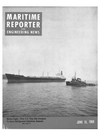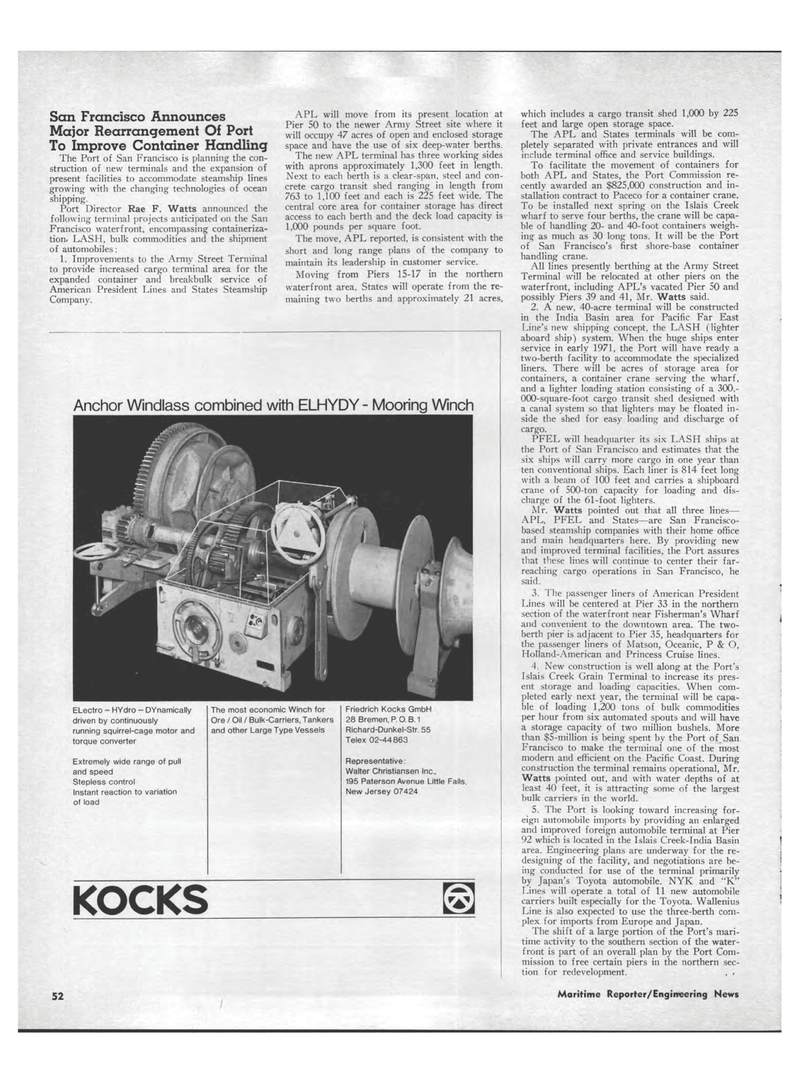
Page 50: of Maritime Reporter Magazine (June 15, 1969)
Read this page in Pdf, Flash or Html5 edition of June 15, 1969 Maritime Reporter Magazine
San Francisco Announces Major Rearrangement Of Port To Improve Container Handling The Port of San Francisco is planning the con-struction of new terminals and the expansion of present facilities to accommodate steamship lines growing with the changing technologies of ocean shipping. Port Director Rae F. Watts announced the following terminal projects anticipated 011 the San Francisco waterfront, encompassing containeriza-tion- LASH, bulk commodities and the shipment of automobiles: 1. Improvements to the Army Street Terminal to provide increased cargo terminal area for the expanded container and breakbulk service of American President Lines and States Steamship Company. APL will move from its present location at Pier 50 to the newer Army Street site where it will occupy 47 acres of open and enclosed storage space and have the use of six deep-water berths. The new APL terminal has three working sides with aprons approximately 1,300 feet in length. Next to each berth is a clear-span, steel and con-crete cargo transit shed ranging in length from 763 to 1,100 feet and each is 225 feet wide. The central core area for container storage has direct access to each berth and the deck load capacity is 1,000 pounds per square foot. The move, APL reported, is consistent with the short and long range plans of the company to maintain its leadership in customer service. Moving from Piers 15-17 in the northern waterfront area, States will operate from the re-maining two berths and approximately 21 acres, which includes a cargo transit shed 1,000 by 225 feet and large open storage space. The APL and States terminals will be com-pletely separated with private entrances and will include terminal office and service buildings. To facilitate the movement of containers for both APL and States, the Port Commission re-cently awarded an $825,000 construction and in-stallation contract to Paceco for a container crane. To be installed next spring on the Islais Creek wharf to serve four berths, the crane will be capa-ble of handling 20- and 40-foot containers weigh-ing as much as 30 long tons. It will be the Port of San Francisco's first shore-base container handling crane. All lines presently berthing at the Army Street Terminal will be relocated at other piers on the waterfront, including APL's vacated Pier 50 and possibly Piers 39 and 41, Mr. Watts said. 2. A new, 40-acre terminal will be constructed in the India Basin area for Pacific Far East Line's new shipping concept, the LASH (lighter aboard ship) system. When the huge ships enter service in early 1971, the Port will have ready a two-berth facility to accommodate the specialized liners. There will be acres of storage area for containers, a container crane serving the wharf, and a lighter loading station consisting of a 300,-000-square-foot cargo transit shed designed with a canal system so that lighters may be floated in-side the shed for easy loading and discharge of cargo. PFEL will headquarter its six LASH ships at the Port of San Francisco and estimates that the six ships will carry more cargo in one year than ten conventional ships. Each liner is 814 feet long with a beam of 100 feet and carries a shipboard crane of 500-ton capacity for loading and dis-charge of the 61-foot lighters. Mr. Watts pointed out that all three lines? APL, PFEL and States?are San Francisco-based steamship companies with their home office and main headquarters here. By providing new and improved terminal facilities, the Port assures that these lines will continue to center their far-reaching cargo operations in San Francisco, he said. 3. The passenger liners of American President Lines will be centered at Pier 33 in the northern section of the waterfront near Fisherman's Wharf and convenient to the downtown area. The two-berth pier is adjacent to Pier 35, headquarters for the passenger liners of Matson, Oceanic, P & O, Holland-American and Princess Cruise lines. 4. New construction is well along at the Port's Islais Creek Grain Terminal to increase its pres-ent storage and loading capacities. When com-pleted early next year, the terminal will be capa-ble of loading 1,200 tons of bulk commodities per hour from six automated spouts and will have a storage capacity of two million bushels. More than $5-million is being spent by the Port of San Francisco to make the terminal one of the most modern and efficient on the Pacific Coast. During construction the terminal remains operational, Mr. Watts pointed out, and with water depths of at least 40 feet, it is attracting some of the largest bulk carriers in the world. 5. The Port is looking toward increasing for-eign automobile imports by providing an enlarged and improved foreign automobile terminal at Pier 92 which is located in the Islais Creek-India Basin area. Engineering plans are underway for the re-designing of the facility, and negotiations are be-ing conducted for use of the terminal primarily by Japan's Toyota automobile. NYK and "K" Lines will operate a total of 11 new automobile carriers built especially for the Toyota. Wallenius Line is also expected to use the three-berth com-plex for imports from Europe and Japan. The shift of a large portion of the Port's mari-time activity to the southern section of the water-front is part of an overall plan by the Port Com-mission to free certain piers in the northern sec-tion for redevelopment. , # Anchor Windlass combined with ELHYDY - Mooring Winch ELectro - HYdro - Dynamically driven by continuously running squirrel-cage motor and torque converter Extremely wide range of pull and speed Stepless control Instant reaction to variation of load The most economic Winch for Ore / Oil / Bulk-Carriers, Tankers and other Large Type Vessels Friedrich Kocks GmbH 28 Bremen, P. O. B. 1 Richard-Dunkel-Str. 55 Telex 02-44863 Representative: Walter Christiansen Inc., 195 Paterson Avenue Little Falls, New Jersey 07424 KOCKS 52 Maritime Reporter/Engineering News

 49
49

 51
51
